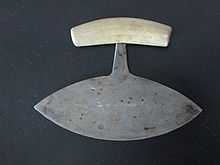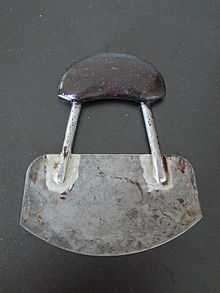Ulu




An ulu (Inuktitut syllabics: ᐅᓗ, plural: uluit, English: "woman's knife"[1]) is an all-purpose knife traditionally used by Yup'ik, Inuit, and Aleut women. It is utilized in applications as diverse as skinning and cleaning animals, cutting a child's hair, cutting food and, if necessary, trimming blocks of snow and ice used to build an igloo.
Name
In the Nunatsiavummiutut dialect, spoken in Nunatsiavut, the word is spelled uluk, and in East Greenlandic it is sakiaq or saakiq and in syllabics is ᓴᒃᑭᖅ.[1]
| language | singular | dual | plural |
| Yukon-Kuskokwim Yup'ik | uluaq | uluak | uluat |
| Chevak Cup’ik | kegginalek | kegginalgek | kegginalget |
| Nunivak Cup'ig | ulluar | ||
| Alaskan Iñupiaq | ulu ~ uluuraq | ||
| Western Canadian Inuit | ulu | ||
| Eastern Canadian Inuit | ulu ᐅᓗ | uluit | |
| Nunatsiavut Inuit | uluk | ||
| Greenlandic Inuit | sakiaq ~ saakiq | ||
| Koyukon Athabascan | tlaabaas | ||
| Holikachuk Athabascan[2] | tthamas |
Materials
Traditionally the ulu was made with a caribou antler, muskox horn or walrus ivory[3] handle and slate cutting surface, due to the lack of metal smelting technology in the Arctic.[4] The handle could also be carved from bone, and wood was sometimes used when it was available. In certain areas, such as Ulukhaktok Northwest Territories, copper was used for the cutting surface.[5]
Today the ulu is still often made with a caribou antler handle but the blade is usually made of steel. The steel is quite often obtained by purchasing a hand saw or wood saw and cutting the blade to the correct shape. A hardwood called sisattaq is also used for handles. These uluit are both kept for home use and sold to others. It is also possible to purchase commercially produced uluit, sometimes made with a plastic handle and complete with a cutting board.
Usage and styles
The size of the ulu typically reflects its usage. An ulu with a 5 cm (2 in) blade would be used as part of a sewing kit to cut sinew. Kimaqtuut is a small ulu used for cutting out patterns from animals skins (seal, caribou) which is the two-inch blade. An ulu with a 15 cm (6 in) blade would be used for general purposes. Occasionally, uluit can be found with blades as large as 30 cm (12 in).
The ulu comes in four distinct styles, the Inupiat (or Alaskan), Canadian, West Greenlandic and East Greenlandic. With the Inupiat style ulu the blade has a centre piece cut out and both ends of the blade fit into the handle.[6] In Canada the blade more often is attached to the handle by a single stem in the centre. In the western areas of the Canadian Arctic the blade of the ulu tended to be of a triangular shape, while in the eastern Arctic the ends of the blade tend to be more pointed.[7][8]
The shape of the ulu ensures that the force is centred more over the middle of the blade than with an ordinary knife. This makes the ulu easier to use when cutting hard objects such as bone. Because the rocking motion used when cutting on a plate or board with an ulu pins down the food being cut, it is also easier to use an ulu one-handed (a typical steak knife, in contrast, requires a fork).
History
Uluit have been found that date back to as early as 2500 BCE. Traditionally, the ulu would be passed down from generation to generation. It was believed that an ancestor's knowledge was contained within the ulu and thus would also be passed on.
Legality
Some countries, including Canada, prohibit the possession or carrying of knives where the blade is perpendicular to the handle (intended to limit the use of so-called "push daggers"). However, the Criminal Code of Canada specifically exempts uluit from this prohibition.[9]
Notes
- ↑ 1.0 1.1 "Ulu". Asuilaak Living Dictionary. Retrieved 2009-02-08.
- ↑ Kari, James. 1978. Holikachuk Noun Dictionary (Preliminary). Fairbanks: Alaska Native Language Center. ERIC ED172528
- ↑ Bering Sea Eskimo Walrus Ivory and Iron Semi-Lunar Knife 'Ulu' (Inuit 1800 to 1900)
- ↑ Canadian Museum of Civilization
- ↑ "Ulu with a musk ox horn handle." British Museum.
- ↑ External image on the Inuipat style ulu
- ↑ External image of the different types of uluit
- ↑ Various uluit
- ↑ Consolidated Regulations of Canada, S.O.R./98-462
External links
| Wikimedia Commons has media related to Uluit. |
| Look up ulu#Inuktitut in Wiktionary, the free dictionary. |
- Collection of uluit in the National Museum of the American Indian
- Images and descriptions of uluit and other Inuit tools and clothing at McCord Museum
- Video showing the use of an ulu
- Various items about uluit at Civilization.ca